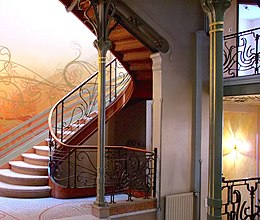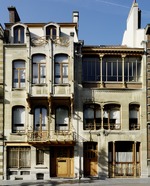Four houses in Brussels, Belgium, designed and built by Art Nouveau architect Victor Horta
The major town houses of Victor Horta are four town houses in Brussels, Belgium, which have been listed as a UNESCO World Heritage Site since 2000. All four houses were designed and built by the Belgian architect Victor Horta (1861–1947), who pioneered the Art Nouveau style during the mid-1890s.
History
Victor Horta was born in Ghent, Belgium, in 1861 and lived for several years in Paris before returning to Belgium to work as an architect in 1880. He achieved rapid success, working on several prestigious buildings and receiving a number of official posts including a position at the Free University of Brussels. From 1892, Horta began working in the new Art Nouveau style. In 1893, he designed the Hôtel Tassel, which is considered the first example of Art Nouveau architecture. He applied the same style to many subsequent buildings, including the Hôtel Solvay (built 1895–1900), Hôtel van Eetvelde (1895–1898) and his own house and workshop (1898). Among the architects who were inspired by Horta's works of the period are Antoni Gaudí and Hector Guimard.[1]
During World War I, Horta went into exile in the United Kingdom and the United States. On returning to Belgium, Horta modified his styles in subsequent buildings, moving away from Art Nouveau towards Art Deco or Modernist styles to take account of changing popular tastes. He died in 1947.
Recognition
The UNESCO commission recognised them in 2000:
The four major town houses – Hôtel Tassel, Hôtel Solvay, Hôtel van Eetvelde, and Maison & Atelier Horta – located in Brussels and designed by the architect Victor Horta, one of the earliest initiators of Art Nouveau, are some of the most remarkable pioneering works of architecture of the end of the 19th century. The stylistic revolution represented by these works is characterised by their open plan, the diffusion of light, and the brilliant joining of the curved lines of decoration with the structure of the building.[2]
The four houses were selected on the basis of their architectural importance but also because of their state of conservation.[2]






